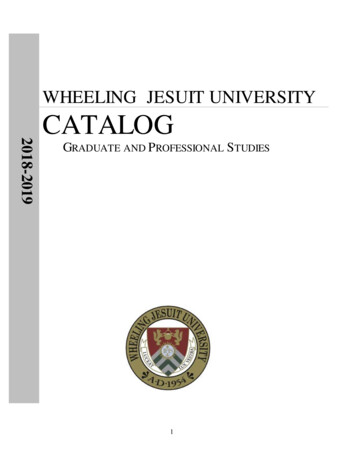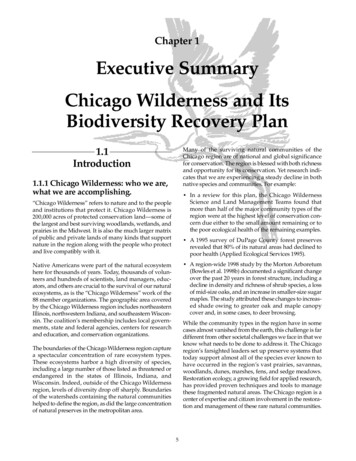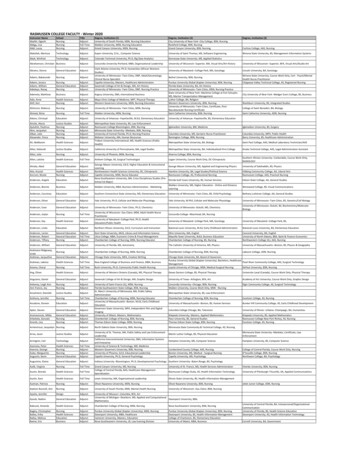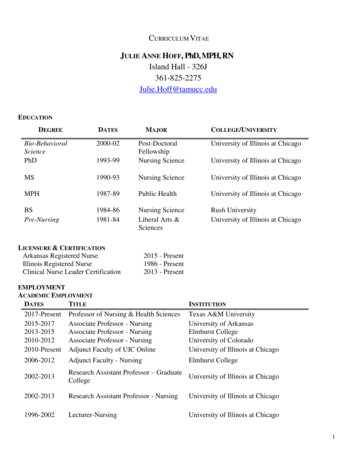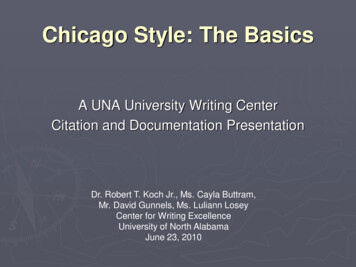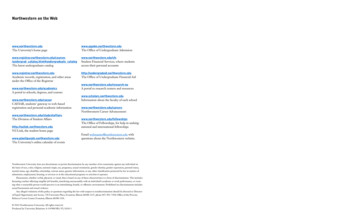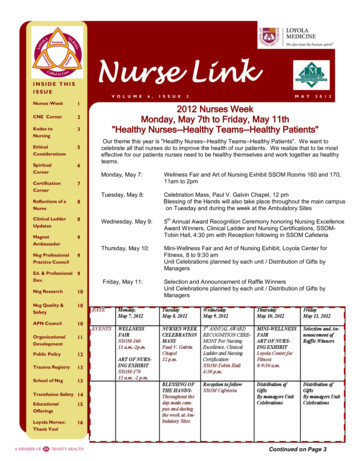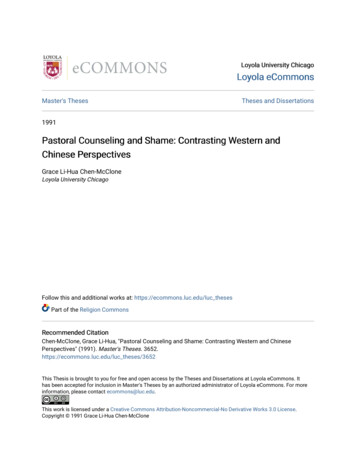
Transcription
Loyola University ChicagoLoyola eCommonsMaster's ThesesTheses and Dissertations1991Pastoral Counseling and Shame: Contrasting Western andChinese PerspectivesGrace Li-Hua Chen-McCloneLoyola University ChicagoFollow this and additional works at: https://ecommons.luc.edu/luc thesesPart of the Religion CommonsRecommended CitationChen-McClone, Grace Li-Hua, "Pastoral Counseling and Shame: Contrasting Western and ChinesePerspectives" (1991). Master's Theses. 3652.https://ecommons.luc.edu/luc theses/3652This Thesis is brought to you for free and open access by the Theses and Dissertations at Loyola eCommons. Ithas been accepted for inclusion in Master's Theses by an authorized administrator of Loyola eCommons. For moreinformation, please contact ecommons@luc.edu.This work is licensed under a Creative Commons Attribution-Noncommercial-No Derivative Works 3.0 License.Copyright 1991 Grace Li-Hua Chen-McClone
PASTORAL COUNSELING AND SHAME:CONTRASTING WESTERN AND CHINESE PERSPECTIVESbyGrace Li-Hua Chen-McCloneA Thesis submitted to Faculty of Graduate School of LoyolaUniversity of Chicago in Partial Fulfillment of theRequirements for the Degreeof Master of ArtsMay1991
c1991 Grace Li-Hua Chen-McCloneAll Rights Reserved
AbstractThis work provides a cross-cultural approach to the pastoral counseling ofshame within a Chinese cultural context. The focus of the work is a contrast ofWestern and Chinese perspectives on the phenomenon of shame throughexploring the theological, psychological, and healing dimensions in each culture.The purpose is to offer a cross-cultural approach to the counseling of shamewithin a Chinese context. The sources fundamental to this study are the religious,psychological, and healing resources that exist within both the Western andChinese cultures. For the Chinese, this means the resources of traditionalChinese religion such as Confucianism, Taoism, and Buddhism.This study concludes that shame is experienced, understood, and treateddifferently in the two cultures. Shame in Chinese culture is much more a socialphenomenon and healing will take place within the context of that entire socialmatrix of the family and clan. So too, the approach of the pastoral counselor willdemand an attention to the unique aspects of shame that flow from that culturalcontext.11.
AcknowledgementsThe author is indebted to the following people:Edward Quinn, M.M. who sent crucial materials from Taiwan helpful inthis study, and offered reflections from his thirty plus years as a missionary toTaiwan, R.O.C.Robert Sears, S.J. Ph.D., for his input, consultation, and time as director ofthis Thesis.Gerard Egan, Ph.D. for his support, input, and affirmation as reader.Frances Belmonte, Ph.D. for her support, encouragement, and valuing ofChinese culture.Kathy Cunningham for her typing assistance and patience.To the many clients, students, and supervisors both here in the States andin Taiwan who have shared their journey of life with the author.iii.
This thesis is dedicated tomymymymymymyhusband, Kevin McCloneGrandfather, Ch Chenfather, Chien-Hsiang Chenmother, Chien-Yen Lin-Chensister, Shu-o Chen-Tsaibrothers, Min-Chiang ChenMiao-Tze ChenIV.
TABLE OF CONTENTSI.II.INTRODUCTION . . . . . . . . . . . . . . . . . . . . . . . . . . . . . . . . . . . . . . .1A.Problem . . . . . . . . . . . . . . . . . . . . . . . . . . . . . . . . . . . . . . . . . . .1B.Previous Research . . . . . . . . . . . . . . . . . . . . . . . . . . . . . . . . 2C.Limitations . . . . . . . . . . . . . . . . . . . . . . . . . . . . . . . . . . . . . . . 3D.Sources . . . . . . . . . . . . . . . . . . . . . . . . . . . . . . . . . . . . . . . . . . . 3E.Methodology . . . . . . . . . . . . . . . . . . . . . . . . . . . . . . . . . . . . . 4F.Defining Shame and Distinguishing Shameand Guilt . . . . . . . . . . . . . . . . . . . . . . . . . . . . . . . . . . . . . . . .5THEOLOGY/PHILOSOPHY/SPIRITUALI'IY OF SHAME:WESTERN AND CHINESE PERSPECTIVES . . . . . . . . . . 7A.Western: Theology/Philosophy/Spirituality . . . . . .OLD TESTAMENT . . . . . . . . . . . . . . . . . . . . . . . . . .NEW TESTAMENT . . . . . . . . . . . . . . . . . . . . . . . . . .a. Introduction . . . . . . . . . . . . . . . . . . . . . . . . . . . . . . .b. Jesus and shame . . . . . . . . . . . . . . . . . . . . . . . . . . .c. Samaritan woman . . . . . . . . . . . . . . . . . . . . . . . . . .d. Jesus and the cross . . . . . . . . . . . . . . . . . . . . . . . . .e. Peter and shame . . . . . . . . . . . . . . . . . . . . . . . . . . .TRADITION . . . . . . . . . . . . . . . . . . . . . . . . . . . . . . . . .WORLDVIEW . . . . . . . . . . . . . . . . . . . . . . . . . . . . . . .799101112131415Chinese: Theology/Philosophy/Spirituality . . . . . .18HISTORICAL OVERVIEW . . . . . . . . . . . . . . . . . . . .ANCESTOR WORSHIP . . . . . . . . . . . . . . . . . . . . . . .CONFUCIANISM . . . . . . . . . . . . . . . . . . . . . . . . . . . .TAOISM . . . . . . . . . . . . . . . . . . . . . . . . . . . . . . . . . . . .BUDDHISM . . . . . . . . . . . . . . . . . . . . . . . . . . . . . . . . .WORLDVIEW . . . . . . . . . . . . . . . . . . . . . . . . . . . . . . .1819202125281.2.3.4.B.71.2.3.4.5.6.v.
111.PSYCHOLOGY OF SHAME: WESTERN AND CHINESEPERSPECTIVES . . . . . . . . . . . . . . . . . . . . . . . . . . . . . . . . . . . . . . . 30A.Western: Psychology of Shame . . . . . . . . . . . . . . . . . . . . 301.2.3.4.5.B.SHAME: A GROWING CONCERN . . . . . . . . . . . .SPECIAL FEATURES OF SHAME . . . . . . . . . . . . .a. Shame as affect . . . . . . . . . . . . . . . . . . . . . . . . . . . . .b. Invisibility of shame . . . . . . . . . . . . . . . . . . . . . . . . .c. An experience common to many . . . . . . . . . . . . . . .d. Multi-Generational . . . . . . . . . . . . . . . . . . . . . . . . .e. Continuum -- Respectful vs. Shame-boundsystems . . . . . . . . . . . . . . . . . . . . . . . . . . . . . . . . . . . .f. Relational . . . . . . . . . . . . . . . . . . . . . . . . . . . . . . . . . .g. Shame -- A complex phenomenon . . . . . . . . . . . . .DEVELOPMENTAL THEORY OF SHAMEIDENTITY AND SELF . . . . . . . . . . . . . . . . . . . . . . . .a. Shame over the life cycle . . . . . . . . . . . . . . . . . . . . .b. Psychological magnification of shame scenes:Defending scripts . . . . . . . . . . . . . . . . . . . . . . . . . . .ADDICTION AND SHAME . . . . . . . . . . . . . . . . . . . .SHAME IN FAMILY SYSTEMS . . . . . . . . . . . . . . . .3032323233343435383838394242Chinese: Psychology of Shame . . . . . . . . . . . . . . . . . . . . 451.2.3.4.5.6.7.8.9.10.11.12.CONCEPT OF FACE (LIEN) . . . . . . . . . . . . . . . . . . .a. Contrasting loss of Face -- East and West . . . . . .b. Positive and negative aspects of Face . . . . . . . . . .c. Examples . . . . . . . . . . . . . . . . . . . . . . . . . . . . . . . . . .SOMATIZATION OF PSYCHOLOGICALPROBLEMS . . . . . . . . . . . . . . . . . . . . . . . . . . . . . . . . . .EMOTIONAL EXPRESSION . . . . . . . . . . . . . . . . . . ."WE" VS. "I" CULTURE. . . . . . . . . . . . . . . . . . . . . . . .A SHAME CULTURE VS. GUILT CULTURE .EXTENDED FAMILY . . . . . . . . . . . . . . . . . . . . . . . . .AUTHORITARIAN FAMILY STRUCTURE .TIGHT SOCIAL CONTROLS VS. RELATIVELYFLEXIBLE CONTROLS . . . . . . . . . . . . . . . . . . . . . . .CONTROL OF EMOTIONS . . . . . . . . . . . . . . . . . . . .FILIAL PIETY OR LOYAL DEVOTION . . . . . . . . .HOLISTIC VS. A DUALISTIC TRADITION . . . . .LOW TOLERANCE FOR AMBIGUITY . . . . . . . . .Vl.454647484952535355565657585858
JV.PASTORAL COUNSELING -- HEALING SHAME.60A.Pastoral Counseling/A Cross-Cultural Approach . . 60B.Western Models of Healing of Shame . . . . . . . . . . . . . 621.2.3.4.5.KAUFMAN . · · ·FOSSUM AND MASON . . . . . . . . . . . .BRADSHAW . . . . . . . . . . . . . . . . . . . . . . . . . . . . . . . . .AUGSBURGER. . . . . . . . . . . . . . . . . . . . . . . . . . . . . . .INTEGRATIVE MODEL . . . . . . . . . . .a.b.c.d.e.f.C.1.TRUST ESTABLISHED . . . . . . . . . . . .NAMING . . . . . . . . . . . . . . . . . . . . . . . . . . . . . . . . . . . .CLAIMING . . . . . . . . . . . . . . . . . . . . . . . . . . . . . . . . . .GRIEVING . . . . . . . . . . . . . . . . . . . . . . . . . . . . . . . . . .INTEGRATING . . . . . . . . . . . . . . . . .SPIRITUAL AWAKENING ANDGENERATIVITY . . . . . . . . . . . . . . . . . . . . . . . . . . . . .767677788081Other Dimensions of Healing Shame inChinese Culture . . . . . . . . . . . . . . . . . . . . . . . . . . . . . . . . . . . 821.2.3.E.7272737374Contrasting Western Models with ChinesePerspectives . . . . . . . . . . . . . . . . . . . . . . . . . . . . . . . . . . . . . . 752.3.4.5.6.D.Trust established . . . . . . . . . . . . . . . . . . . . . . . . . . .Naming . . . . . . . . . . . . . . . . . . . . . . . . . . . . . . . . . . .Claiming . ·Grieving . . . . . . . . . . . . . . . . . . . . . . . . . . . . . . . . . . .Integrating . . . . . . . . . . . . . . . . . . . . . . . . . . . . . . . .Spiritual awakening and generativity . . . . . . . . . . .626467697171ATTITUDES TOWARD HEALING . . . . . . . . . . . .ROLE OF FAMILY . . . . . . . . . . . . . . .COUNSELOR/CLIENT RELATIONSHIPS . . . . . .828384Theological/Spiritual Reflection of Healing Shame: ACross-Cultural Approach . . . . . . . . . . . . . . . . . . . . . . . . . 851.2.3.4.5.FILIAL PIETY . . . . . . . . . . . . . . . . . . . . . . . . . . . . . . .RESTORING HONOR . . . . . . . . . . . . .METAPHOR OF EXILE . . . . . . . . . . . . . . . . . . . . . .RESPECT . . . . . . . . . . . . . . . . . . . . . . . . . . . . . . . . . . . .SPIRITUAL SOURCES OF HEALING . . . . . . . . . .8586878789V.CONCLUSION . . . . . . . . . . . . . . . . . . . . . . . . . . . . . . . . . . . . . . . . . 90VI.REFERENCES . . . . . . . . . . . . . . . . . . . . . . . . . . . . . . . . . . . . . . . . . 92Vll.
I. INTRODUCTIONA.ProblemIn this past year, I took a course on Healing in the Family, where classmembers were to choose a topic for study. I chose to write on the area of shame.This initial reflection on the phenomenon of shame expanded my interest in thiscomplex subject. In particular, I found myself reflecting on how prevalent shame wasin my various experiences; my ten years of Clinical Pastoral Education supervisingstudents, my four years of Crisis Counseling in Taiwan, my counseling here in thestates, and my own personal and family life experience.A central question for me in my reflections on shame was the differences inWestern and Chinese perceptions of shame. My last five years here in the Stateshave taught me that Western psychology flows out of Western philosophical thoughtand often is in sharp contrast with many of my own Chinese values andunderstandings.Consequently, I became interested in how shame might beunderstood in a totally different philosophical and religious worldview. For example,in my elementary school in Taiwan, R.O.C., my home country, there were four keywords that hung over the entrance to the school: (1) "Li," which meant propriety, anattendance to ritual, ceremony, and courtesy, a sense of respect, honor, andemotional balance, (2) "Yi," meaning righteousness; a virtuous obedience to1
2communal values, (3) "Lien," meaning clean, honest, and upright, and finally (4)"ch'ih," meaning shame, disgrace, humiliation, to feel ashamed. These four virtuesof which shame was one, were the Chinese equivalence of Western faith. Theysymbolized the spirit of what it meant to be fully human, whereas in the West, shameis a wound to be overcome.As a pastoral counselor, I hope to return to my home country of Taiwanwithin this next year and offer my learning and insights gained from the West. Inorder to most effectively serve the needs of my own people, I must be able tointegrate what I have learned here and apply it to my own Chinese cultural context.Specifically, I see shame as such a crucial aspect within my own culture, and I felt Ineeded to look at the pastoral counseling of shame in a cross-cultural framework.This research is an attempt to contrast the approaches to shame in the West and inChinese culture, highlighting both the common themes and critical differences. Myhope is to come up with some insights and approaches to the pastoral counseling ofshame that are appropriate for Chinese clients, whether Chinese-Americans in theUnited States or Chinese persons in their native lands. The questions that I seek toexplore are 1. Where does shame come from in Chinese culture? 2. How is itdifferent from the West?3.How is it similar?4. What differences in theapproaches to healing or pastoral counseling of shame are there? and 5. Howimportant are cultural variables in our understanding and treatment of shame?B.Previous ResearchThe previous research in this area is very limited. While there has been a lot
3written on shame and its treatment in the West, little has been explored with regardto the treatment or healing of shame in Chinese culture. Even more rare is the focuson shame from a pastoral counseling perspective. Pastoral counseling is new, evenhere in the States, and in China and Taiwan, it is even newer yet. What I did findhelpful was some insightful reflections by Howard Clinebell (1986) in his contrast ofpastoral psychology and care in China and the West. While this material was limitedto one brief article, it did give me an initial focus for further research.C.LimitationsA major difficulty in my research was having somewhat limited access tooriginal Chinese sources. However, I did find the two books sent from Taiwan byFather Edward Quinn, The PsycholoID' of Chinese People, Eberhard (1973) and Guiltand Sin in Traditional China, Bond (1986) to be very valuable resources for me.Another limitation has to do with the reality that pastoral counseling is so new inChinese culture and Taiwan. Consequently, there is little material that deals directlywith pastoral counseling in Chinese culture, much less pastoral counseling and shame.D.SourcesOutside of the two books sent from Taiwan by Father Edward Quinn, therewere several key articles that helped in my research on Chinese and shame. Just tomention a few key ones, the article by Shon and Ja (1983) on "Asian families," hadsome useful research on the dynamics of shame among Asians; Toupin's article(1980), on "Counseling Asians," helped look at insights for pastoral counseling andshame, and Tseng and Wu's book Chinese Culture and Mental Health (1985),
4contained numerous articles that greatly facilitated my research.As far as shame in the West, I found Kaufman (1980, 1989) to be a centralresource, due to his extensive research on the subject as well as his organized andcomprehensive approach.Other key sources were Augsburg's book, Pastoralcounseling Across Cultures ( 1986), Bradshaw's Healing the Shame That Binds You(1988), and Possum's and Mason's Facing Shame (1986). Together, these sourceshelped provide me with an integrated understanding of shame from the West inorder to provide a starting point for contrasting it from a Chinese cultural context.E.MethodologyMy aim is to present a contrast of shame from Western and Chineseperspectives.In so doing, I hope to highlight a cross-cultural approach to theunderstanding and treatment of shame from the Chinese perspective. I will beginwith looking at Western philosophical, theological, and spiritual thought with regardto this phenomenon of shame. Next, I will offer a contrast, by focusing on theChinese worldview, with its unique philosophical, religious, and spiritual orientations.Having explored these ancient sources, I will turn to the psychological understandingsof shame from both Western and Chinese vantage points.In the third major section of this work, I will focus on the healing of shamefrom a pastoral counseling perspective. I will begin by exploring four Westernmodels of healing shame, and then offer an integrative model based on this survey.From this integrative model, I will offer a critique from a Chinese culturalperspective. In addition to the critique, I will also highlight some other central
5dimensions of healing that are crucial to consider when counseling Chinese. Finally,I will offer some spiritual and theological reflections on pastoral counseling shamethat integrate both Chinese and Judeo-Christian spiritual sources.F.Defining Shame and Distinguishing Shame and GuiltAlthough shame has been the topic of numerous psychological andanthropological investigations, it still remains a difficult emotion to conceptualize.In the Dictionary of Pastoral Care and Counseling (Hunter, ed., 1990) defines shameas a painful feeling of being exposed, uncovered, unprotected, vulnerable.Etymologically, the lndo-European roots from which shame derives means, "to cover."There is no consensus at the present regarding the dynamics, meaning,valuation of shame, or even terminology for shame. The most widespread confusionregards the distinctions between shame and guilt. Authors differ on what thesedistinctions are and this adds to the confusion. However, there are some commondistinctions that most agree on, such as guilt relates more to acts while shameinvolves one's sense of identity (Hunter, 1990; Kaufman, 1989; Morris, 1971).Gerhart Piers (1953) set forth what has become the standard psychoanalyticdistinction between shame and guilt. Both are defined structurally as the productsof tension between the ego and superego. Shame is a response to failure and theshortcomings of the self in relation to the ego ideal; guilt is in response totransgression. Also, shame is more inseparably connected to feeling than guilt. Aperson can be guilty without feeling guilty. Alternately, he or she may feel guiltywithout being guilty. But if a person feels ashamed, he or she is ashamed (Hunter,
61990).Another critical distinction that I wish to highlight is that generally speaking,guilt is more about something I did or did not do, while shame is the revelation ofsomething which I am. Finally, shame seems peculiarly social, inseparable from one'ssense of "face" and "losing face." To say that to be ashamed is to be ashamed ofoneself is to point to the connection of shame and one's identity. What one is, ofcourse, is broader than simply what one has consciously chosen. It involves all thatone identifies with or wishes to be identified with (Hunter, 1990).In Chineseculture, this identity is intimately intertwined with the family, clan, and society(Eberhard, 1973).
II.THEO LOGY/PHILOSOPHY/SPIRITUALITYWESTERN AND CHINESE PERSPECTIVESA.OFSHAME:Western: Theology/Philosophy /Spirituality1.OLD TESTAMENTAs a pastoral counselor, I seek to draw upon the riches of scripture to speakto this phenomenon of shame. Although the Western Christian tradition in the postbiblical period has neglected the phenomenon of shame and has failed to give itsustained reflection, the Scriptures are filled with references to shame. The biblicalstory indeed begins with the human experiences of anxiety, shame, and guilt. Placedin an anxiety context of taboos with life and death sanctions, the man and womandare not transgress the divine prohibitions. Naked, yet unashamed, they live in aparadise of innocence until willful disobedience disrupts all. Anxiety triggers flight;shame reveals nakedness. The two persons experience the anxiety surrounding seeingand being seen, knowing evil and being known by it, acting willfully and beingexposed in it -- these are the components of shame (Augsburger, 1986).According to The Dictionary of Pastoral Care and Counseling (1990), shameand its derivatives appear 195 times in the Old Testament, and 46 times in the NewTestament. In exploring biblical references to shame, another author confirms thispredominance of shame-related words in the Old Testament.Some exemplarypassages he notes are Hosea 4:6-7; Jeremiah 3: 24-25; Ezra 9:6-7; or the sharp7
8contrast between Psalm 31, with its pure expression of shame, and Psalm 32 with itsfocused expression of guilt and yearning for forgiveness. This same author notes thatthe word "shame" occurs eight times more often than guilt in the total scriptures(Augsburger, 1986).In examining further these Old Testament references to shame, we find someinteresting similarities. For example, a central theme seems to be the emergence ofshame whenever there is a turning away from the covenantal relationship establishedby God. Shame emerges as the Israelites turn to various idols and fail to trust inYahweh's providence. As one researcher notes,There is a rich cluster of shame-related terms used in Scripture: todishonor, disgrace, ridicule, humiliate, scorn, reproach, confound, taunt,scoff, naked, and face (e.g., Ps. 44, 13-15; Noble, 1975, p. 27). Thoughshame is associated with many sins, from theft to prostitution, it ismost centrally the result of idolatry (Hunter, 1990, p. 1161).The other theme that seems to emerge is God's fidelity and constant love thatcontinually calls people back into relationship and communion. Another author alsonotes this theme and sees it operative in all of scripture as he states,Throughout the biblical accounts, human shame and guilt occur in thiscontext of grace offered as steadfast love. All human activity, whetherhonorable or shameful, responsible or guilty, occurs in this context ofthe unchanging steadfast love of the Creator which constantly draws allcreatures toward wholeness and healing (Augsburger, 1986, p. 139).God's fidelity and unconditional love offers the care and support that allowstrust to replace anxiety, acceptance to restore honor where we are shamed, andforgiveness to resolve guilt. Herbert Morris, in his book Guilt and Shame (1971),states that in an experience of shame, trust is seriously jeopardized or destroyed.
9The greater the expectation, the more acute the shame; the greater the discrepancybetween one's image of oneself and the image others have of one, the more one hasto "put on a brave face" (Morris, 1971).This is indeed a basic theme throughout the Old Testament, where Godcontinually remains faithful and calls his people back. God responds to the shameof his people by bringing it into the open, and calling for a spiritual cleansing (eg.,Ezechial: 36). Yahweh will cleanse them from their idols and place a "new heart,and a new spirit" in them. The sin is named and brought into the open to beforgiven and healed.2.NEW TESTAMENTa.IntroductionHaving explored shame in the Old Testament, we now turn to the usage ofshame within the New Testament. Shame occupies a much less prominent place inthe New Testament.Almost all new Testament references speak of shame asdisgrace (e.g., "who.endured the cross, despising the shame," Heb. 12:2). Theabsence of the sense of shame is most strikingly evident in the original Greek(Hunter, 1990). Aidos, the Greek word for the positive sense of shame, which linksit with awe and the sacred, appears but once.Augsburger (1986), in his research, also notes that shame is used lessfrequently than guilt, and concern for the sense of shame seems almost missing. Thelack of shame among the early Christians is shown in their desacralization of holyplaces, their demystification of ritual, the bold claiming of intimacy with God, and
10the broad inclusion of people from all races, ranks, and levels in the community ofgrace.b.Jes us and ShameThe origins of shame involve a severing of the interpersonal bridge.(Kaufman, 1980). The fundamental trust one longs for and expects is violated andcontrolling defenses emerge keeping the person from risking, loving, and developingintimate relationships. There is a strong consensus among New Testament scholarsthat one of the characteristic features of Jesus of Nazareth was his remarkably freeand intimate relationship with God. As is well known, the affectionate term, abba,an Aramaic diminutive for "father" used by both children and adults in addressingtheir fathers, may have been Jesus' habitual way of addressing God in prayer (cf. Mk14:36). Such an address for God in prayer is practically without analogy in Jewishpiety and contrasts with reverential formality and elaborate address typical ofintertestamental Jewish piety (Senior and Stuhlmueller, 1983).While Jesus himself was undoubtedly a strict Jew, there are examples wherehe summons up his own authority and own experience to place the values of innerintegrity in direct confrontation with his opponents interpretation of the law (Seniorand Stuhlmueller, 1983). In particular, Jesus brings healing where there was shame,and shames those who set themselves up as judges. Jesus breaks with the sociallyand religiously prescribed customs of his day and shares table fellowship with outcastpublic "sinners," and or tax collectors (cf., for example, Mt. 9:10, 11:19, Mk 2:15-17,Lk. 7:31-35). He shows an open attitude toward the despised Samaritan (cf., for
11example, Lk. 10:10-37; 17:11-19; John 4). He freely associates with women, includingthem in his community of disciples, openly conversing with them, and publiclyaccepting their signs of affection and loyalty -- actions taboo and shameful for apublic religious teacher in the patriarchal society of Jesus' day (cf., for example, Lk7:36-50; 8:1-3; Jn 4:27, et.).These provocative associations of Jesus' are not incidental to his ministry.The extension of compassion, loyalty, and friendship across well-defined boundariesof exclusion was a parable in action, a way of vividly communicating Jesus'understanding of God and the quality of his rule. A good example of this is the storyof the sinful woman who came to Jesus in the house of a pharisee. (Lk. 7:36-50) Thewoman, who the gospel says, "had a bad name in the town," (v. 37) was living withshame.Upon hearing of Jesus' dining there, she brought an alabaster jar ofointment. She waited behind him at his feet, weeping, and her tears fell on his feet.She wiped the tears with her hair, covering his feet with kisses. The woman wasforgiven because, as the gospel states, she had shown such "great love" (v. 47). Whatthis story seems to indicate is a reversal of shame or perhaps better, atransformation. Jesus heals what is regarded as shameful and exposes the blindnessof those who have no shame.c.Samaritan WomanAnother central example of how Jesus deals with shame is the gospel story ofthe Samaritan woman at the well (Jn. 4:1-30).In this story, Jesus meets theSamaritan woman at the well. He acknowledges her presence and asks her for a
12drink (v. 7). Jesus risks his own shame by associating with a Samaritan and a woman(v. 9-10).What Jesus does is to accept this woman.He doesn't shame her.However, he does confront the truth about her life. Jesus brings her shame out ofhiding and names it by acknowledging her five husbands, yet doesn't condemn her.He speaks the truth (v. 19), and invites her to a life of "spirit" and "truth" (v. 23).The woman was going to the well alone, cut off from the community through herfeelings of shame. She was isolated, alienated, and Jesus' acceptance of her allowsher to be transformed, to be restored to relationship. She is empowered in herhealing to be reunited to the community. Healing occurs in facing fully one's shamein the presence of another and finding acceptance. The acceptance allows forforgiveness and reconciliation, restoration to self, God, and others.d.Jes us and the CrossJesus himself was the victim of shameful experiences.The Phariseesquestioned him (Lk. 22:54-62). Jesus was lonely, afraid, and felt anguish (Lk: 39-46),but remained truthful to himself and turned to God in prayer. In his later life, Jesuswould be "mocked," (Lk: 22:63), (Lk: 23:36), "unjustly accused," (Lk 23:1-7), "madefun of," and "treated with contempt" (Lk 23: 10-12), paraded through the streets to bepublicly humiliated and later crucified (Lk 23:26-32) (Boff, 1981). This reality ofshame of the cross is central to Christianity as Donald Capps so aptly states,Crucified as a common criminal in full public view, Jesus experiencedshame of the most excruciating kind. Its injury to self was incalcuable.Thus, to view life from the perspective of the cross, as Christians do,is to embrace our shameful selves, for Jesus' experience on the crossis the paradigmatic shame experience for Christians (Capps, 1983, p.92).
13Jesus experienced tremendous pain both physically and emotionally. He knewshame and ridicule to the point where his "anguish" led to the sweating of blood (Lk22 :44 ). Jesus found hope for overcoming these shameful experiences by turning toGod in prayer (Lk 22:42, 21-36, 19:41-42). Jesus embraced the shame and allowedhimself to grieve and "shed tears" over Jerusalem (Lk 19:41). The experiences ofrejection and abandonment threatened to block him from risking anymore and hecried out to. "Abba," to find the answers. In turning to his creator, he reaffirmed hisdeepest identity and acceptance in God and found the courage to keep his integrity.e.Peter and ShameAnother illustration of shame in the New Testament is in Peter's denial ofJesus. Jesus had told his followers that they would all lose faith in him (Mt 26:31).Peter responded to Jesus in public denial, "though all lose faith in you, I will neverlose faith," and Jesus proclaims that Peter indeed will "disown him three timesbefore the night is over" (Mt 26:34 ). Peter answers for the third time that, "even ifI have to die with you, I will never disown you" (v. 35). Peter was called by Jesus tobe a leader. He was the "rock" upon which the "Church" would be built (Mt 16: 18).Peter's shame was magnified because of this special relationship and responsibility.Peter, the one who affirmed boldly Jesus as the Christ, the Messiah of God, had nowdisowned him not once, but three times (Mt 26:69-75).The response of Peter was to "weep bitterly" (Mt 26:75). Peter had deniedChrist
the treatment or healing of shame in Chinese culture. Even more rare is the focus on shame from a pastoral counseling perspective. Pastoral counseling is new, even here in the States, and in China and Taiwan, it is even newer yet. . ( 1986 ), Bradshaw's Healing the Shame That Binds You (1988), and Possum's and Mason's Facing Shame (1986 .
